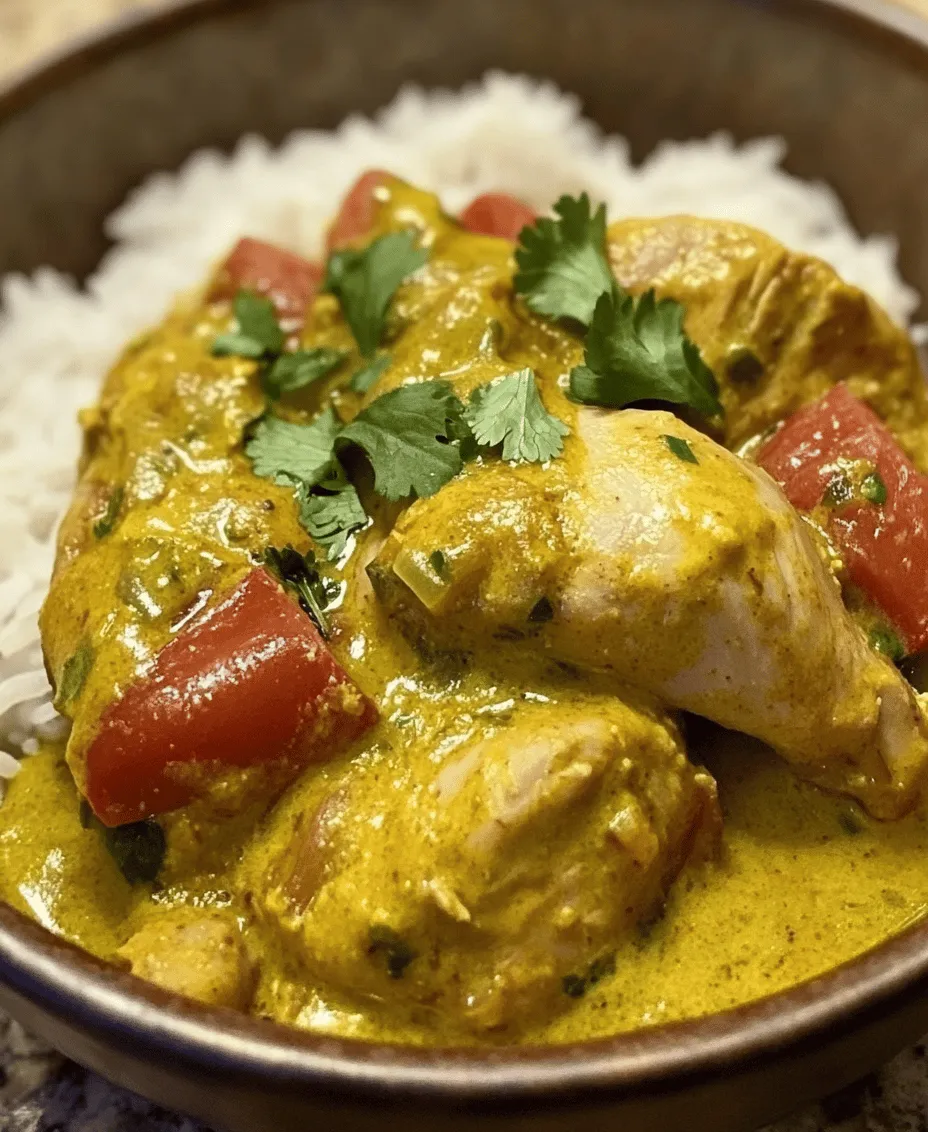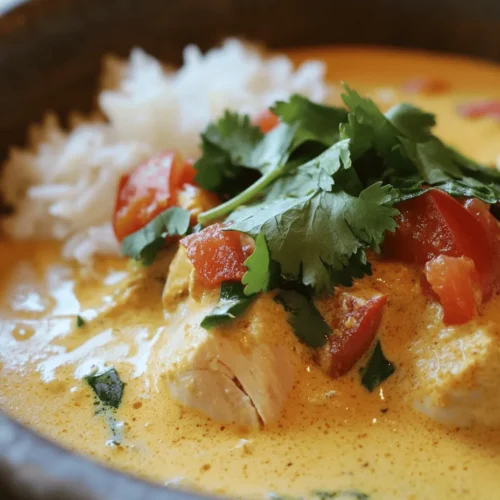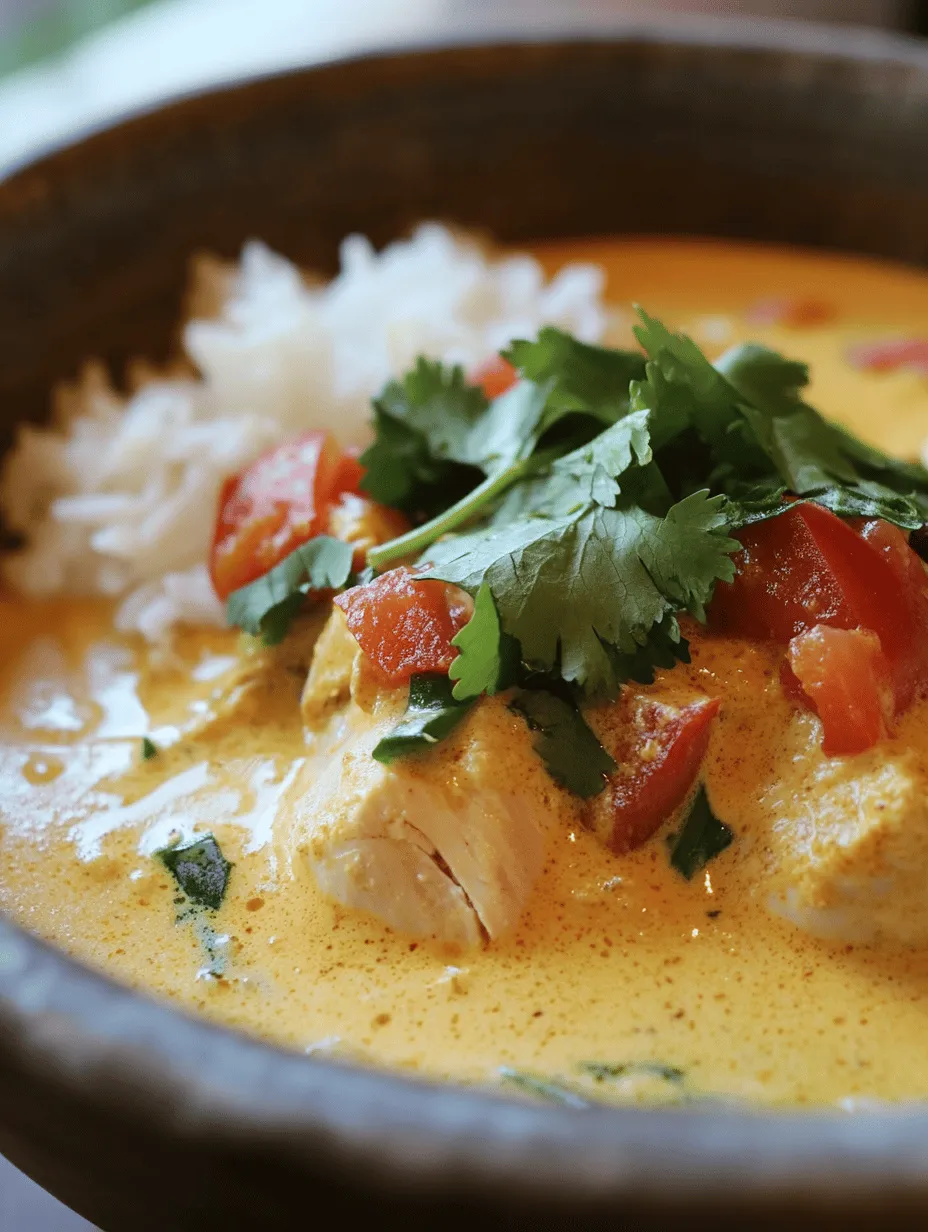Introduction: Exploring the Rich Flavors of Kuku Paka
Kuku Paka, a traditional dish from East Africa, encapsulates the essence of vibrant culinary heritage through its harmonious blend of flavors and textures. This delectable recipe features succulent chicken simmered in a luscious coconut milk sauce, enriched with a medley of spices that evoke the warmth and color of East African cuisine. As you delve into the world of Kuku Paka, you will discover not just a meal, but a celebration of culture, history, and the communal spirit of sharing food.
The name “Kuku Paka” derives from the Swahili words “kuku,” meaning chicken, and “paka,” which translates to “to coat” or “to spread.” The dish is a testament to the influences of various cultures that have mingled in East Africa, including Arab, Indian, and indigenous African cuisines. Each bite of Kuku Paka is a journey that tells the story of the region’s rich history, making it a cherished favorite among locals and an exotic delight for those exploring new culinary landscapes.
In this article, we will take you through a detailed exploration of the Kuku Paka recipe, providing insights into its ingredients and their cultural significance. Whether you are an experienced cook or a culinary novice, this guide will equip you with the knowledge and confidence to create an unforgettable dining experience right in your kitchen.
Understanding Kuku Paka: A Cultural Insight
The Origins of Kuku Paka
Kuku Paka has deep roots in the coastal regions of East Africa, particularly in Kenya and Tanzania. Historically, the dish emerged as a result of trade routes that facilitated the exchange of spices and ingredients between different cultures, including Arab traders and Indian laborers who settled along the Indian Ocean coast. This cross-cultural influence is evident in the dish’s combination of spices and cooking techniques, which reflect a blend of African and Asian culinary traditions.
The method of cooking chicken in a coconut-based sauce is not exclusive to Kuku Paka; variations of coconut chicken dishes can be found throughout the Indian Ocean islands, such as in the Maldives and Mauritius. However, Kuku Paka stands out due to its unique use of local spices like cumin, coriander, and cardamom, which elevate the dish and provide a distinct flavor profile.
Coconut milk plays a pivotal role in East African cooking, serving as a key ingredient in many traditional dishes. Its creamy texture not only enhances the taste but also adds nutritional benefits, making it a staple in regional cuisine. The use of coconut in Kuku Paka symbolizes the rich natural resources of the coastal regions, where coconut palms thrive, and the significance of coconut milk as a source of nourishment and flavor can be traced back through generations.
The Ingredients that Make Kuku Paka Special
A successful Kuku Paka relies on its carefully selected ingredients, each playing a vital role in creating the dish’s signature taste. Here are the key components that contribute to the allure of Kuku Paka:
1. Chicken: The primary protein in this dish, chicken is marinated to infuse flavor and tenderness. You can use various cuts, such as thighs or drumsticks, which are ideal for absorbing the rich coconut sauce.
2. Coconut Milk: This creamy ingredient is the heart of Kuku Paka, providing a luscious base for the sauce. It balances the spices and adds a tropical flair that is characteristic of East African cuisine.
3. Onions, Garlic, and Ginger: These aromatic ingredients form the flavor foundation of the dish. When sautéed, they release essential oils that enhance the overall aroma and taste, creating a fragrant base for the coconut sauce.
4. Spices: A combination of spices, including cumin, coriander, turmeric, and cardamom, elevates the dish’s flavor profile. These spices contribute warmth and depth, highlighting the rich culinary traditions of the region.
5. Vegetables: While the emphasis is on chicken, incorporating vegetables such as bell peppers and tomatoes adds color, texture, and nutritional value to the dish.
6. Green Chilies: For those who enjoy a bit of heat, fresh green chilies can be added to the dish. They provide a spicy kick that beautifully complements the creamy coconut sauce.
7. Fresh Herbs: Garnishing the finished dish with fresh herbs like cilantro or parsley not only adds a burst of color but also enhances the flavor, offering a fresh contrast to the rich sauce.
Nutritional Benefits of the Main Components
Kuku Paka is not only a delicious dish but also a nutritious one. Here are some of the health benefits associated with its key ingredients:
– Chicken: A great source of lean protein, chicken is essential for muscle repair and growth. It is also rich in vitamins and minerals, including B vitamins and phosphorus.
– Coconut Milk: While it is higher in calories than some other milk alternatives, coconut milk is a source of healthy fats, particularly medium-chain triglycerides (MCTs). These fats can provide quick energy and may support metabolic health.
– Onions, Garlic, and Ginger: These ingredients are known for their anti-inflammatory properties and immune-boosting benefits. They contain antioxidants that can help reduce the risk of chronic diseases.
– Spices: Many spices used in Kuku Paka, such as turmeric and cumin, are celebrated for their health benefits, including anti-inflammatory and digestive properties.
– Vegetables: Incorporating a variety of vegetables into the dish adds essential vitamins, minerals, and fiber, contributing to a well-rounded meal.
Step-by-Step Guide to Making Kuku Paka
Preparing the Chicken: The Marination Process
To achieve the best flavor in Kuku Paka, marinating the chicken is a crucial step. Marination allows the spices to penetrate the meat, enhancing its flavor and tenderness. Here’s how to marinate your chicken effectively:
1. Choose Your Chicken: Select your preferred cuts of chicken, such as thighs or drumsticks. Bone-in pieces are recommended, as they tend to stay juicier during cooking.
2. Create the Marinade: In a large bowl, combine yogurt, lemon juice, and spices such as cumin, coriander, turmeric, and salt. The acidity from the yogurt and lemon juice helps to tenderize the chicken while infusing it with flavor.
3. Marinate: Coat the chicken pieces in the marinade, ensuring they are evenly covered. Cover the bowl with plastic wrap or transfer the chicken to a resealable plastic bag. Allow the chicken to marinate for at least 1 hour, or ideally overnight in the refrigerator. The longer the chicken marinates, the more flavorful it will become.
4. Bring to Room Temperature: Before cooking, remove the chicken from the refrigerator and let it sit at room temperature for about 30 minutes. This step helps the chicken cook more evenly.
Sautéing the Aromatics: Building Flavor Foundations
Once the chicken has marinated, it’s time to build the flavor foundation for Kuku Paka through sautéing the aromatics. This step is essential for creating a rich and fragrant sauce.
1. Heat the Oil: In a large, heavy-bottomed pot or skillet, heat a few tablespoons of oil (such as vegetable or coconut oil) over medium heat. Allow the oil to become hot but not smoking.
2. Sauté the Onions: Add finely chopped onions to the pot and sauté them until they become translucent and golden brown, about 5-7 minutes. Stir occasionally to ensure even cooking and prevent burning.
3. Add Garlic and Ginger: Once the onions are caramelized, add minced garlic and ginger to the pot. Sauté for an additional 1-2 minutes until fragrant, stirring continuously to avoid burning the garlic.
4. Adjust Heat with Green Chilies: If you enjoy a bit of spice, now is the time to add chopped green chilies. Adjust the quantity according to your heat preference. Sauté for another minute, allowing the flavors to meld together.
Incorporating Vegetables and Spices: The Heart of the Dish
With the aromatics sautéed, it’s time to incorporate the vegetables and spices that will bring Kuku Paka to life.
1. Add the Vegetables: Stir in diced bell peppers and tomatoes, cooking for about 5 minutes until the vegetables soften. This will add texture and flavor depth to the dish.
2. Introduce the Spices: Sprinkle in the remaining spices—cumin, coriander, and cardamom—stirring to coat the vegetables evenly. Toasting the spices in the oil will release their essential oils and enhance their flavors.
3. Build the Sauce: Pour in the coconut milk, stirring to combine with the sautéed ingredients. Allow the mixture to come to a gentle simmer, which will create a rich and flavorful sauce for the chicken.
4. Add Marinated Chicken: Gently place the marinated chicken pieces into the pot, ensuring they are submerged in the coconut sauce. Bring the mixture to a simmer, cover the pot, and let it cook until the chicken is tender and fully cooked through.
As the Kuku Paka simmers, the aroma will fill your kitchen, inviting everyone to gather around the table. In the next part of this article, we will continue with the remaining steps to perfect this beloved East African dish, including tips for serving and variations that can elevate your Kuku Paka experience.

The Importance of Using Fresh Tomatoes
When it comes to making Kuku Paka, the choice of tomatoes can significantly impact the overall flavor of the dish. Fresh tomatoes are essential; they provide a natural sweetness and acidity that enhances the complexity of the sauce. Using fresh tomatoes instead of canned ones ensures that your Kuku Paka has a vibrant taste and bright color. The freshness of the tomatoes will contribute to a more robust sauce and help balance the richness of the coconut milk. Look for ripe, juicy tomatoes, preferably vine-ripened, as they tend to be sweeter and more flavorful.
If you can’t find fresh tomatoes, consider using high-quality canned tomatoes as a last resort. However, to mimic the freshness, try to add a small pinch of sugar to balance the acidity of the canned variety. For an extra layer of flavor, you can roast your fresh tomatoes before adding them to the pot. This process caramelizes the sugars and adds depth to the sauce.
Balancing Spices: Understanding Curry Powder, Cumin, Turmeric, and Coriander
Achieving the perfect balance of spices is crucial in Kuku Paka. Each spice contributes a unique flavor profile that, when combined, creates a harmonious blend.
– Curry Powder: This is often a mixture of various spices, including turmeric, cumin, coriander, and sometimes fenugreek or chili powder. Its warm, earthy flavor is foundational to Kuku Paka. When using curry powder, start with a smaller quantity and adjust according to your taste preferences.
– Cumin: Known for its warm, nutty flavor, cumin enhances the dish’s overall aroma and depth. To release its full potential, consider toasting whole cumin seeds in a dry pan before grinding them into a powder. This will elevate the flavor profile of your Kuku Paka.
– Turmeric: This vibrant yellow spice is known for its health benefits and provides Kuku Paka with its signature golden hue. It has a mild flavor, so it’s a perfect addition to balance the stronger spices.
– Coriander: Ground coriander adds a citrusy note that brightens the dish. Its subtle taste complements the other spices without overpowering them.
Experimenting with these spices allows you to personalize your Kuku Paka. Adjust the quantities according to your preference, but always remember to taste as you go. A well-balanced spice mix can turn a good dish into a great one.
Cooking the Chicken: Techniques for Perfect Texture
The chicken is the star of Kuku Paka, and cooking it properly is key to achieving tender, juicy pieces. Here are some techniques to ensure your chicken comes out perfectly every time:
Tips for Browning Chicken to Seal in Moisture
Browning the chicken before simmering it in the coconut sauce is essential for flavor and texture. Begin by patting the chicken pieces dry with paper towels to ensure a good sear. Heat oil in a large skillet or pot over medium-high heat, then add the chicken pieces in a single layer. Avoid overcrowding the pan, as this can cause the chicken to steam instead of brown.
Cook the chicken for about 5-7 minutes on each side until it forms a golden-brown crust. This initial browning not only enhances the flavor but also seals in the juices, resulting in moist chicken throughout the cooking process. Once browned, remove the chicken from the pan and set it aside while you prepare the sauce.
How to Monitor Cooking Times for Tenderness
Cooking times can vary based on the size and cut of your chicken. For bone-in pieces, aim for a total cook time of approximately 25-30 minutes in the coconut sauce, while boneless cuts will take about 15-20 minutes. To ensure the chicken is fully cooked and tender, use a meat thermometer to check for an internal temperature of 165°F (75°C).
If using larger cuts like thighs or legs, consider simmering them longer in the sauce to allow the flavors to meld and the meat to become even more tender. The key is to monitor the chicken occasionally, turning it in the sauce to prevent any burning and to ensure even cooking.
Creating the Coconut Sauce: The Creamy Element
The coconut sauce is what elevates Kuku Paka from a simple chicken dish to an exotic culinary experience. Here’s how to create a creamy, flavorful sauce that envelops the chicken beautifully.
The Process of Adding Coconut Milk and Ensuring a Smooth Sauce
After browning the chicken, use the same pot to prepare your sauce. Start by sautéing chopped onions, garlic, and ginger in the residual oil until they are soft and fragrant. Then, add the fresh tomatoes and cook until they break down and create a thick base.
Gradually stir in the coconut milk, ensuring to scrape up any browned bits from the bottom of the pan, as they add depth to your sauce. For a smooth texture, whisk the coconut milk into the mixture until fully combined. If you prefer a thicker sauce, allow it to simmer uncovered for a few extra minutes, stirring occasionally.
Adjusting the Consistency of the Sauce to Your Preference
The consistency of your coconut sauce can be adjusted based on personal preference. If you like a thinner sauce, feel free to add a splash of chicken stock or water to achieve your desired consistency. For a thicker sauce, allow it to simmer longer, or consider adding a tablespoon of cornstarch mixed with a bit of water to thicken it quickly.
Taste the sauce before adding the chicken back in; this is your chance to adjust the seasoning. You can add more salt, spices, or a squeeze of lime juice for acidity and brightness.
Final Touches: Garnishing and Serving Suggestions
A dish is not complete without the perfect garnishes and serving suggestions to enhance the overall dining experience.
The Role of Fresh Cilantro in the Dish
Fresh cilantro is a traditional garnish for Kuku Paka, adding a burst of color and a fresh, herbal flavor that balances the richness of the coconut sauce. Finely chop a handful of cilantro leaves and sprinkle them over the dish just before serving. If you’re not a fan of cilantro, fresh parsley or green onions can be excellent alternatives.
Traditional Accompaniments: Rice or Chapati Options
Kuku Paka is typically served with a side of rice or chapati. Both options are ideal for soaking up the flavorful coconut sauce.
– Rice Varieties: Basmati rice is a popular choice due to its fluffy texture and fragrant aroma. Alternatively, you can opt for jasmine rice or even coconut rice for an added layer of flavor.
– Chapati Preparation: For those who prefer bread, chapati is a traditional East African flatbread made from whole wheat flour. It is easy to prepare at home and provides a delightful chewy texture that pairs beautifully with Kuku Paka.
Pairing Kuku Paka with Sides and Beverages
To elevate your Kuku Paka experience, consider serving it with complementary side dishes and beverages.
Ideal Side Dishes to Complement Kuku Paka
In addition to rice or chapati, you can enhance your meal with other popular East African dishes:
– Ugali: This staple dish made from maize flour is a perfect accompaniment to Kuku Paka. Its dense texture absorbs the sauce beautifully.
– Sukuma Wiki: This sautéed kale dish adds a nutritious element and contrasts nicely with the richness of the chicken.
– Kachumbari: A fresh tomato and onion salad that adds brightness and crunch to the meal, balancing the creamy coconut sauce.
Beverage Recommendations for a Complete Meal
Choosing the right beverage can enhance the flavors of your meal. Traditional drinks that pair well with Kuku Paka include:
– Tuskers Beer: A popular East African lager that complements the spices in the dish without overpowering them.
– Chai Tea: A spiced tea that can be enjoyed before or after the meal, providing a warm and comforting finish.
– Fresh Coconut Water: This hydrating drink not only pairs well with the dish but also enhances the coconut flavor present in Kuku Paka.
Conclusion: Savoring the Essence of Kuku Paka
Kuku Paka is more than just a meal; it is a celebration of East African culinary traditions. The combination of spices, coconut milk, and tender chicken creates a dish that is both comforting and exotic. By following this comprehensive guide, you can bring the vibrant flavors of East Africa into your home kitchen. Whether enjoyed with family or shared with friends, Kuku Paka promises to be a memorable dining experience, inviting all to savor its rich history and delightful taste. Embrace the essence of Kuku Paka, and let it inspire you to explore the incredible world of East African cuisine.



